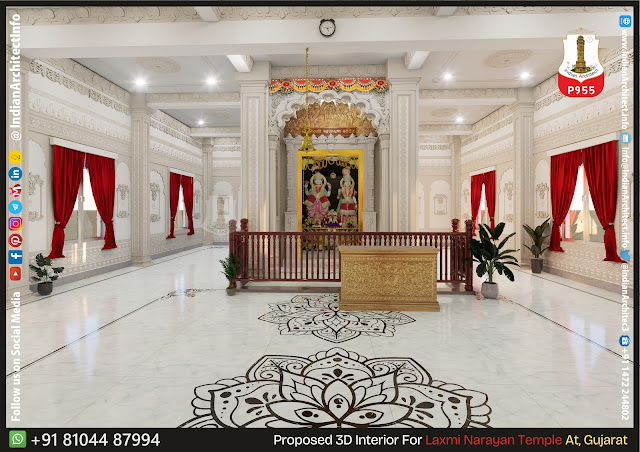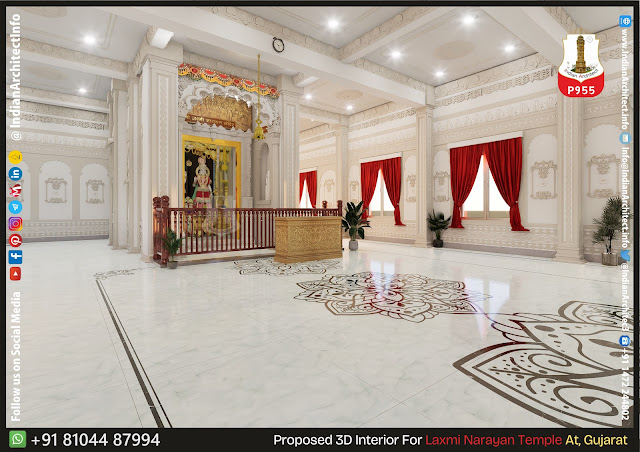These images depict a well-designed Laxmi Narayan Temple interior that blends traditional architectural elements with modern design principles to create a sacred and visually stunning space.
Architectural and Interior Design of the Laxmi Narayan Temple
I. Overall Architectural Style and Concept
The design of the temple reflects a harmonious blend of traditional Indian temple architecture with modern interpretations. Its core objective is to establish a sacred and visually captivating space conducive to worship and spiritual reflection. Key defining characteristics include:
- Traditional Indian Temple Architecture: The design integrates quintessential elements of traditional Indian temple construction, such as a raised platform for the deity, ornate carvings, and a symmetrical layout, providing a foundational aesthetic.
- Grandeur and Opulence: A sense of majesty and reverence is achieved through the extensive use of marble, intricate detailing, and various decorative elements.
- Open and Airy Space: The temple hall is specifically designed to be spacious and well-lit, thereby fostering a comfortable and peaceful atmosphere ideal for devotees.
II. Architectural Features
- Raised Platform (Sanctum Area): A prominent raised platform is clearly visible, serving as the designated space for the idols of Laxmi and Narayan. This feature is fundamental to Hindu temple architecture.
- Arched Openings: Arches are a recurring and significant architectural motif, employed for doorways and niches, which contributes to the traditional aesthetic.
- Columns and Pilasters: The main hall is structurally supported by a series of columns and pilasters, frequently adorned with decorative capitals.
- Ceiling Design: The ceilings are characterized by multiple levels and intricate patterns, often featuring a central point that may include a chandelier.
- Flooring: The primary flooring material is marble, which consistently includes a distinct design or pattern drawn upon its surface, adding to its visual appeal.
- Lighting (Integrated): The illumination strategy combines natural light, filtered through windows, with artificial lighting, including chandeliers, recessed lights, and sconces, to create a balanced ambiance.
III. Interior Design Elements
- Deities (Idols): The central and most revered element within the temple is the beautifully adorned idols of Laxmi and Narayan, serving as the primary focal point.
- Ornate Carvings: Detailed and intricate carvings are extensively applied to the walls, pillars, and ceilings. These carvings depict a variety of subjects, including deities, floral patterns, and geometric designs.
- Color Palette: The dominant color scheme is a serene combination of white and gold, which conveys a sense of purity and divinity. Accents of red and other colors are introduced primarily through the deity's clothing and various decorations.
- Decorative Patterns (Flooring): Beyond the general marble flooring, the surface frequently incorporates intricate patterns, significantly enhancing the visual richness and aesthetic appeal of the floor.
- Lighting Fixtures: Decorative lighting elements such as chandeliers and other specific light fixtures are carefully selected and positioned to illuminate the space and foster a warm and inviting atmosphere.
- Textiles: Rich and luxurious fabrics are utilized for elements such as curtains, canopies, and the clothing that adorns the deities.
- Plants: Potted plants are occasionally introduced into the interior, providing a touch of natural greenery and freshness.
- Religious Symbols: Elements such as bells and other traditional religious symbols are present, collectively contributing to and enhancing the sacred ambiance of the temple.
More details of this project
Blog: https://www.indianarchitect.info/2025/01/P955.html
IA Greeting: https://iagreeting.blogspot.com/2025/05/P955.html








No comments:
Post a Comment